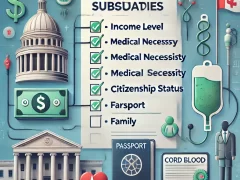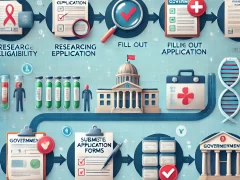
Maximizing Government Grants for Cord Blood Banking
Strategies for Securing Government Grants for Cord Blood Banking
Securing government grants can be a game-changer for cord blood banking organizations, providing the necessary funding to expand operations, enhance research, and ultimately, improve patient outcomes. As the demand for cord blood banking services continues to grow, navigating the complex landscape of government grant opportunities becomes increasingly crucial. In this article, we’ll explore proven strategies to help you maximize your chances of obtaining these valuable financial resources.
Understand the Landscape of Government Grants
The first step in securing government grants for cord blood banking is to familiarize yourself with the landscape of available funding opportunities. Research federal, state, and local government agencies that offer grants related to healthcare, biomedical research, or community development. Keep an eye out for grants specifically tailored to stem cell research, regenerative medicine, or public health initiatives. Stay up-to-date with grant announcement deadlines and application requirements to ensure you’re well-prepared.
Conduct a Comprehensive Needs Assessment
Before applying for a government grant, conduct a thorough assessment of your organization’s needs. Identify the specific areas where additional funding would have the greatest impact, such as upgrading infrastructure, expanding storage capacity, enhancing donor recruitment efforts, or advancing research initiatives. This comprehensive understanding of your organization’s needs will enable you to craft a compelling grant proposal that aligns with the grant-maker’s priorities.
Craft a Compelling Grant Proposal
The success of your grant application often hinges on the quality and persuasiveness of your proposal. Invest time in crafting a well-structured, carefully researched, and compelling narrative that highlights the importance of your cord blood banking initiatives. Clearly articulate your organization’s mission, goals, and the specific ways in which the grant funding will be utilized to achieve tangible outcomes. Emphasize the potential impact on the community, the advancement of medical research, and the improvement of patient care.
Demonstrate Collaboration and Partnerships
Government grant-makers often favor applications that demonstrate collaborative efforts and strategic partnerships. Highlight any existing relationships you have with healthcare providers, research institutions, or community organizations that can amplify the reach and impact of your cord blood banking initiatives. Demonstrate how the grant funding will enable you to strengthen these partnerships and foster new collaborations that benefit the broader community.
Highlight Your Organization’s Expertise and Track Record
Showcase your organization’s expertise, experience, and track record in the field of cord blood banking. Highlight the qualifications and credentials of your team, the success of your past initiatives, and any awards or recognition your organization has received. This will help to establish your credibility and increase the grant-maker’s confidence in your ability to effectively utilize the funding.
Comply with Reporting Requirements
Securing a government grant is just the first step – maintaining compliance with reporting requirements is crucial. Familiarize yourself with the grant-maker’s reporting guidelines, including deadlines, format, and the type of information required. Establish robust record-keeping and reporting systems to ensure timely and accurate submissions, demonstrating your organization’s commitment to transparency and accountability.
By leveraging these strategies, cord blood banking organizations can navigate the complex world of government grants and unlock the financial resources necessary to drive innovation, expand services, and ultimately, make a lasting impact on the field of regenerative medicine.
Maximizing Government Grants for Cord Blood Banking
Cord blood banking is a process that has gained significant attention in recent years, offering parents the opportunity to preserve their newborn’s valuable stem cells for potential future use. However, the costs associated with cord blood banking can be a significant barrier for many families. Fortunately, there are government grants available that can help alleviate the financial burden and make this valuable service more accessible.
Understanding Cord Blood Banking
Cord blood is the blood that remains in the umbilical cord and placenta after a baby is born. This blood is a rich source of stem cells, which have the potential to be used in the treatment of various medical conditions, such as leukemia, lymphoma, and certain genetic disorders. By banking this cord blood, parents can ensure that these stem cells are available if needed in the future.
Exploring Government Grants for Cord Blood Banking
Recognizing the importance of cord blood banking, many government agencies have established grant programs to support families in accessing this service. These grants can cover a significant portion of the costs associated with cord blood banking, making it more affordable for a wider range of individuals.
One of the most well-known government grant programs for cord blood banking is the Newborn Screening Saves Lives Reauthorization Act, which provides funding for states to establish and maintain newborn screening programs. This includes the potential for grants to be used towards the cost of cord blood banking.
Additionally, some states have their own grant programs specifically designed to assist families with the expenses of cord blood banking. For example, the California Umbilical Cord Blood Collection Program offers grants to eligible residents to cover the costs of cord blood collection and storage.
Applying for government grants for cord blood banking can be a complex process, but it is essential to take the necessary steps to ensure that you maximize the available funding opportunities.
The first step is to research the various grant programs available in your state or at the federal level. This can involve exploring the websites of state health departments, as well as searching for information on the websites of national organizations, such as the National Marrow Donor Program.
Once you have identified the relevant grant programs, you will need to carefully review the eligibility criteria and application requirements. This may include providing information about your family’s financial situation, the medical history of your newborn, and the specific cord blood banking service you have chosen.
It is important to note that the application process may vary depending on the grant program, so it is crucial to follow the instructions carefully and submit all required documentation.
Maximizing Your Chances of Receiving a Grant
To increase your chances of receiving a government grant for cord blood banking, it is essential to be proactive and thorough in your application process. This may involve seeking assistance from professional grant writers or consulting with organizations that specialize in helping families navigate the cord blood banking landscape.
Additionally, it is important to stay up-to-date on any changes or updates to the grant programs, as eligibility criteria and funding levels may change over time. By staying informed and being persistent in your efforts, you can maximize your chances of securing the financial assistance you need to ensure that your newborn’s valuable stem cells are preserved for potential future use.
Government grants for cord blood banking can be a valuable resource for families who are interested in preserving their newborn’s stem cells but are concerned about the associated costs. By understanding the process, exploring the available grant programs, and navigating the application process effectively, you can take advantage of these funding opportunities and make cord blood banking more accessible and affordable for your family.
Strategies for Securing Funding for Cord Blood Initiatives
Expanding Cord Blood Initiatives Through Government Grants
Navigating the complex world of government grants can be a daunting task, but for those involved in the cord blood banking industry, it’s a critical component to securing the necessary funding to drive initiatives forward. By understanding the key strategies for maximizing government grant opportunities, cord blood banking organizations can unlock the resources needed to expand their reach and impact.
Identify Relevant Government Grant Programs
The first step in securing government grants for cord blood initiatives is to identify the relevant programs that align with your organization’s goals and objectives. Research federal, state, and local government agencies that offer funding opportunities in the healthcare, life sciences, or research and development sectors. Look for grants that specifically target cord blood banking, regenerative medicine, or biomedical innovation.
Understand Grant Eligibility and Requirements
Once you’ve identified potential grant opportunities, carefully review the eligibility criteria and application requirements. Ensure that your organization meets all the necessary qualifications, such as nonprofit status, research capabilities, or specific project focus areas. Pay close attention to deadlines, submission guidelines, and any required documentation or supporting materials.
Craft a Compelling Grant Proposal
The success of your grant application will largely depend on your ability to craft a compelling and well-structured proposal. Begin by clearly articulating the problem your cord blood initiative aims to address and the impact it will have on the community or industry. Outline your project’s objectives, methodology, and expected outcomes, and demonstrate how the requested funding will be utilized to achieve these goals.
Highlight the Uniqueness of Your Cord Blood Initiative
To stand out from the competition, emphasize the unique aspects of your cord blood initiative. This may include innovative technologies, partnerships with leading research institutions, or a proven track record of successful projects. Demonstrate how your approach differs from existing solutions and how it will contribute to advancing the field of cord blood banking and regenerative medicine.
Leverage Partnerships and Collaborations
Strengthening your grant application by showcasing strategic partnerships and collaborations can significantly improve your chances of securing funding. Collaborate with industry experts, academic institutions, or healthcare organizations to showcase the breadth of expertise and resources backing your cord blood initiative.
Demonstrate Measurable Outcomes and Impact
Clearly articulate the measurable outcomes and potential impact of your cord blood initiative. Provide data-driven projections of how the grant funding will translate into tangible results, such as increased cord blood donations, advancements in research, or improved access to life-saving therapies.
Maintain Meticulous Grant Management
If your grant application is successful, it’s crucial to maintain meticulous grant management practices. Ensure that you comply with all reporting requirements, financial guidelines, and deadlines set forth by the granting agency. Proper record-keeping, transparent communication, and timely updates will not only safeguard your current funding but also strengthen your chances of securing future grants.
By leveraging these strategies for securing government grants, cord blood banking organizations can unlock the resources needed to expand their initiatives, drive innovation, and make a lasting impact on the healthcare landscape.
Optimizing Cord Blood Banking Operations with Government Grants
Unlocking Financial Support: Maximizing Government Grants for Cord Blood Banking
Cord blood banking has emerged as a critical healthcare service, offering invaluable opportunities for medical research and life-saving treatments. However, the operational costs associated with maintaining a cord blood bank can be substantial, often creating a financial barrier for organizations seeking to establish or expand their services. Fortunately, government grants can provide a vital source of funding to help overcome these challenges.
Identifying Relevant Grant Opportunities
The first step in maximizing government grants for cord blood banking is to thoroughly research available funding opportunities. Reach out to local, state, and federal agencies that offer grants for healthcare initiatives, biomedical research, or stem cell technology development. Additionally, explore grant programs specifically tailored to the cord blood banking industry, such as those offered by the National Institutes of Health (NIH) or the U.S. Department of Health and Human Services (HHS).
Crafting Compelling Grant Proposals
Once you have identified suitable grant programs, the next crucial step is to craft a compelling proposal that showcases the unique value and potential of your cord blood banking operation. Emphasize the long-term benefits of your services, such as the ability to support life-saving therapies, contribute to groundbreaking medical research, and improve patient outcomes. Highlight your organization’s expertise, infrastructure, and commitment to quality standards, as these factors can significantly strengthen your application.
Demonstrating Financial Need and Impact
Securing government grants often requires demonstrating a clear financial need and the potential for meaningful impact. Provide a detailed breakdown of your operational costs, including expenses for equipment, staff, storage, and ongoing maintenance. Illustrate how the grant funding will enable your organization to expand its reach, enhance patient access, or pursue innovative research initiatives. By effectively communicating the financial challenges and the transformative impact of the grant, you can increase the likelihood of securing the necessary funding.
Complying with Grant Requirements
Successful grant applications are not the end of the journey; they come with a set of strict compliance requirements that must be meticulously followed. Familiarize yourself with the reporting, auditing, and record-keeping protocols mandated by the granting agency. Ensure that your organization has the necessary systems and processes in place to accurately track and document the use of grant funds, as this will be crucial for maintaining the trust of the funding source and securing future support.
Cultivating Ongoing Relationships
Building and maintaining strong relationships with government agencies and grant-making organizations can be instrumental in securing sustainable funding for your cord blood banking operations. Attend industry events, participate in relevant conferences, and actively engage with policymakers and grant administrators. Demonstrating your organization’s commitment to transparency, accountability, and continued excellence can help you become a trusted partner in the eyes of potential grantors.
By leveraging government grants, cord blood banking organizations can overcome financial barriers, expand their reach, and enhance their ability to contribute to the advancement of medical science and patient care. By following these strategies for maximizing grant opportunities, you can unlock the resources necessary to drive innovation, improve access to life-saving therapies, and solidify your position as a leader in the cord blood banking industry.
Emerging Trends in Cord Blood Banking and Grant Opportunities
Maximizing Government Grants for Cord Blood Banking
In the rapidly evolving world of cord blood banking, staying ahead of the curve is crucial for organizations seeking to secure government grants. As new trends emerge and funding opportunities arise, it’s essential to have a deep understanding of the landscape and a strategic approach to maximize your chances of success.
Identifying Emerging Trends in Cord Blood Banking
The cord blood banking industry is undergoing significant transformations, driven by advancements in medical research and the growing recognition of the therapeutic potential of cord blood stem cells. Closely monitoring these trends can help you align your grant proposals with the priorities of funding agencies.
One such trend is the increasing focus on personalized medicine and the use of cord blood stem cells for regenerative therapies. Government grants may be available to support research and development in these areas, as well as the establishment of specialized cord blood banking facilities.
Another emerging trend is the expansion of public-private partnerships in cord blood banking. Funding agencies are often interested in projects that foster collaboration between healthcare providers, researchers, and industry stakeholders. By demonstrating your ability to forge these partnerships, you can enhance the competitiveness of your grant applications.
Identifying Relevant Government Grant Opportunities
Navigating the myriad of government grant programs can be a daunting task, but it’s crucial to do your due diligence. Research federal, state, and local funding sources that align with your organization’s goals and expertise in cord blood banking.
The National Institutes of Health (NIH), for instance, offers various grant programs that support research and infrastructure development in the field of regenerative medicine, including the use of cord blood stem cells. Similarly, the U.S. Department of Health and Human Services (HHS) and the Centers for Disease Control and Prevention (CDC) may have funding opportunities relevant to your cord blood banking initiatives.
At the state level, many governments have established grant programs to promote the growth of the biotechnology and life sciences sectors, which can include support for cord blood banking projects. Identifying these state-level funding sources can be particularly valuable for organizations with a strong regional presence.
Crafting Compelling Grant Proposals
Once you’ve identified the relevant grant opportunities, the next step is to craft a compelling proposal that showcases your organization’s expertise, innovative approaches, and alignment with the funding agency’s priorities.
Emphasize the potential impact of your cord blood banking initiatives, whether it’s advancing regenerative medicine, improving public health outcomes, or fostering economic development. Demonstrate your team’s track record of success and your ability to effectively manage and execute the proposed project.
Additionally, be sure to address any specific requirements or evaluation criteria outlined by the funding agency. This may include providing detailed budgets, timelines, and performance metrics to demonstrate the feasibility and viability of your project.
Building Partnerships and Collaborations
Successful grant applications often rely on strong partnerships and collaborations. Seek out opportunities to collaborate with healthcare providers, research institutions, and industry leaders in the cord blood banking space. These partnerships can not only strengthen your proposal but also provide access to additional resources and expertise.
Leveraging the expertise and networks of your partners can enhance the credibility of your grant application and increase your chances of securing funding. Additionally, highlighting the synergies and complementary strengths of your collaborative efforts can make your proposal more compelling to funding agencies.
Continuous Improvement and Adaptation
Securing government grants is an ongoing process that requires continuous improvement and adaptation. Regularly review the changing landscape of funding opportunities, emerging trends, and best practices in the cord blood banking industry. Continuously refine your grant proposals, incorporate feedback, and stay agile in your approach to maximize your chances of success.
By staying informed, leveraging strategic partnerships, and crafting compelling grant proposals, organizations in the cord blood banking sector can navigate the evolving funding landscape and unlock the resources needed to drive innovation, expand their reach, and ultimately, improve patient outcomes.
Conclusion
Securing government grants can be a game-changer for cord blood banking organizations, providing the necessary funding to expand operations, invest in research and development, and stay ahead of the curve in this rapidly evolving industry. By navigating the complex landscape of cord blood banking and strategically aligning their initiatives with the priorities of government grant programs, these organizations can unlock a world of opportunities.
One of the key strategies for maximizing government grants involves thoroughly understanding the current trends and emerging developments in the cord blood banking sector. As regenerative medicine and cell-based therapies continue to gain traction, governments are increasingly recognizing the potential of cord blood as a valuable source of stem cells. By closely monitoring grant programs that align with these advancements, cord blood banking organizations can position themselves as leaders in the field and secure the funding they need to drive innovation.
Moreover, optimizing cord blood banking operations with government grants can lead to significant improvements in efficiency, quality, and accessibility. Grants can enable organizations to invest in state-of-the-art technology, enhance storage and processing capabilities, and expand their donor recruitment efforts. This, in turn, can increase the availability of cord blood units, making them more accessible to patients in need of life-saving treatments.
Navigating the complex web of government grant programs can be a daunting task, but cord blood banking organizations can increase their chances of success by employing strategic planning and a thorough understanding of the application process. This may involve assembling a dedicated team of grant writers and researchers, staying up-to-date on grant deadlines and eligibility criteria, and crafting compelling proposals that clearly demonstrate the organization’s alignment with the grant’s objectives.
Securing government grants can also have a profound impact on the overall growth and sustainability of cord blood banking initiatives. With a reliable source of funding, organizations can invest in long-term projects, expand their donor recruitment efforts, and establish partnerships with healthcare providers, research institutions, and other stakeholders. This, in turn, can lead to increased awareness, public engagement, and the development of innovative therapies that leverage the power of cord blood stem cells.
As the field of cord blood banking continues to evolve, the role of government grants in shaping its future cannot be overstated. By maximizing these funding opportunities, cord blood banking organizations can drive advancements in regenerative medicine, improve access to life-saving treatments, and ultimately, enhance the well-being of individuals and communities around the world.



















